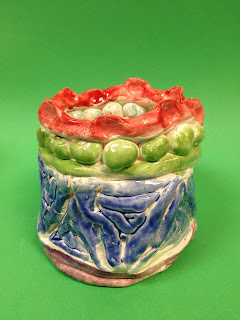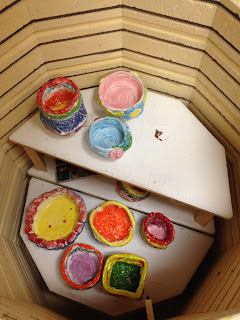Monet Water Lilies
Grade 1
 |
Portrait
Claude Monet |
 |
| Water Lily Pond |
Students viewed the work of Claude Monet. We focused and learned about his garden with a Japanese Bridge and pond with water lilies. Paying attention to the shadows, colors, and lines that give the impression of the surroundings Monet would have seen in person, for he was fascinated with capturing the affects of light. Sometimes Monet would paint a subject over and over again but at different times of day or during the year. Examples of these works include his haystacks, morning views of the Seine river, a railroad station in Paris called Gare Sainte Lazre, Poplar trees, the Palace of Westminister in London, the facade of the Rouen Cathedral, and water lilies.
I've seen several art teachers and different versions of this project online. Each year I've taught this lesson, I seem to think of a new idea or approach. Sometimes you have to just experiment with what materials or results works best with each class and this lesson has progressively changed in different ways.
Version # 1 - Tempera Cake & Oil Pastel
I paired the students up into groups of two. Each team worked together to paint the water with tempera cakes. We overlapped colors of greens, blues, whites, and purples to make the lines of the water. The painted water paper had to dry on the drying rack and we proceeded with learning how to draw the Japanese bridge with shadows using oil pastels. In the next class period, we tore the painted water paper in the middle and gave the other half to our partner. This was glued down underneath the bridge area and then we began drawing and cutting out grass and lily pads. Tissue paper for the flowers were added as well.
 |
| Student Work # 1 |
 |
| Student Work #2 |
Version # 2 - Watercolor & Oil Pastel
Students started the project by painting with watercolors and using saran wrap to spread and blend the colors. Careful attention was made to place the warm colors for the sunset towards the top and the cool colors for the water at the bottom. While the watercolor paper was drying, students began drawing the grass and lilly pads. Next class, the Japanese bridge was drawn with oil pastels with the black for the shadows. To complete the project students finished gluing the grass, lily pads, and tissue paper flowers. Another option is to take oil pastels to emphasize the movement or appearance of water before students glue down the bottom pieces.
 |
Background Paper
Watercolor with Saran wrap |
 |
| Student Work # 3 |
 |
Student Work # 4
(Oil Pastel added at bottom for the water) |

























































